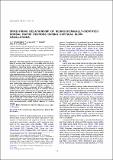Files in this item
Spike-timing relationship of neurochemically-identified dorsal raphe neurons during cortical slow oscillations
Item metadata
| dc.contributor.author | Schweimer, J. V. | |
| dc.contributor.author | Mallet, N. | |
| dc.contributor.author | Sharp, T. | |
| dc.contributor.author | Ungless, M. A. | |
| dc.date.accessioned | 2021-07-16T11:30:28Z | |
| dc.date.available | 2021-07-16T11:30:28Z | |
| dc.date.issued | 2011-11-24 | |
| dc.identifier | 275054194 | |
| dc.identifier | 2c680ac2-36d7-4116-ad1a-6456561cba15 | |
| dc.identifier | 80054029557 | |
| dc.identifier | 21925244 | |
| dc.identifier.citation | Schweimer , J V , Mallet , N , Sharp , T & Ungless , M A 2011 , ' Spike-timing relationship of neurochemically-identified dorsal raphe neurons during cortical slow oscillations ' , Neuroscience , vol. 196 , pp. 115-123 . https://doi.org/10.1016/j.neuroscience.2011.08.072 | en |
| dc.identifier.issn | 0306-4522 | |
| dc.identifier.other | ORCID: /0000-0002-5968-3534/work/108119029 | |
| dc.identifier.uri | https://hdl.handle.net/10023/23593 | |
| dc.description | This work was supported by grant U120085816 from the U.K. Medical Research Council (MRC) , a University Research Fellowship from The Royal Society and grant GAT2848 from The Gatsby Charitable Foundation to M.A.U. | en |
| dc.description.abstract | The firing activity of dorsal raphe neurons is related to arousal state. However, it is unclear how this firing activity is precisely related to cortical activity, in particular oscillations occurring during sleep rhythms. Here we conducted single-cell extracellular recordings and juxtacellular labelling while monitoring electrocorticogram (ECoG) activity in urethane anaesthetised rats, to relate activity in neurochemically identified groups of neurons to cortical slow-wave activity (SWA). We observed that electrophysiological heterogeneity in dorsal raphe neurons revealed different neurochemical groups of DRN neurons and was mirrored by significant differences in the phase and strength of coupling to the cortical slow oscillations. Spike firing relationship of clock-like neurons, identified as 5-HT (5-hydroxytryptamine) or serotonin neurons, was higher during the inactive component of the oscillations. In contrast, half of the identified bursting 5-HT neurons did not exhibit strong cortical entrainment; those that did fired most during the inactive component of the SWA. Two groups of putatively non-5-HT neurons (irregular slow-firing and fast-firing) exhibited significant coherence and fired most during the active component of the SWA. These findings indicate that within the DRN electrophysiologically and neurochemically discrete neuronal groups exhibit distinct relations to cortical activity. | |
| dc.format.extent | 9 | |
| dc.format.extent | 3262740 | |
| dc.language.iso | eng | |
| dc.relation.ispartof | Neuroscience | en |
| dc.subject | 5-HT | en |
| dc.subject | Basal ganglia | en |
| dc.subject | Dopamine | en |
| dc.subject | Limbic system | en |
| dc.subject | Serotonergic | en |
| dc.subject | RC0321 Neuroscience. Biological psychiatry. Neuropsychiatry | en |
| dc.subject | Neuroscience(all) | en |
| dc.subject.lcc | RC0321 | en |
| dc.title | Spike-timing relationship of neurochemically-identified dorsal raphe neurons during cortical slow oscillations | en |
| dc.type | Journal article | en |
| dc.contributor.institution | University of St Andrews. School of Psychology and Neuroscience | en |
| dc.identifier.doi | 10.1016/j.neuroscience.2011.08.072 | |
| dc.description.status | Peer reviewed | en |
This item appears in the following Collection(s)
Items in the St Andrews Research Repository are protected by copyright, with all rights reserved, unless otherwise indicated.

